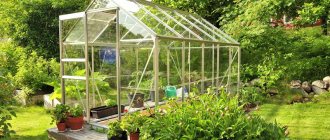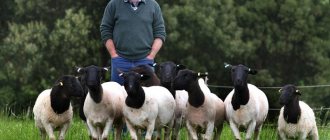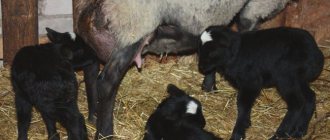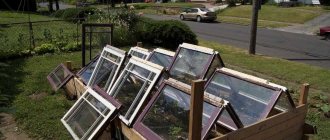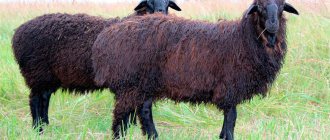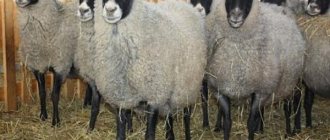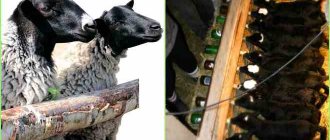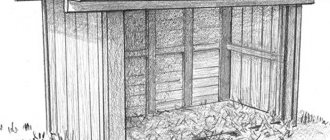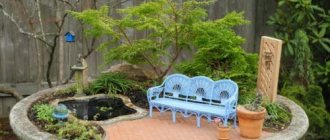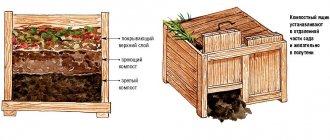How to make a sheepfold with your own hands: steps
In winter, a warm room for a flock of sheep will not hurt.
You can build a sheepfold yourself without involving specialists. To do this, choose a suitable location, calculate the dimensions and begin construction. You need to go through the following stages: pour the foundation, install the frame, and the roof. Equip the floors, arrange the room inside.
Be sure to read this: When sheep are sheared: tools, methods and stages of shearing
Barn foundation
Shed foundation
A budget option for a foundation for lightweight buildings is a columnar foundation. The site is cleared of debris and markings are made using pegs and rope.
Holes are drilled to install supports. The depth is chosen lower than the freezing point of the soil in the region. Another 20 cm is added to the calculated measurement for a sand cushion. The distance between the pits is 1.5 meters around the perimeter, several meters inside depending on the size.
The inner frame of the post is knitted from reinforcement. Formwork is formed around it from plastic pipes and roofing felt. The protrusion above the ground surface is equal to the height of the future floor.
Place a layer of sand at the bottom of the holes. Water and compact. A piece of roofing felt is placed on top. This will prevent moisture from getting into the sand from the concrete solution. The holes are filled with concrete mixture. To prevent air from collecting in the supports, it is knocked out with an iron rod. The structures are left to dry completely.
The height of the supports is controlled with a laser level. After the concrete has completely dried, the formwork is removed. Roofing felt is laid on the heads for waterproofing.
barn frame
Material for the frame is used at hand: logs, boards, straw. The building is being built quickly. The only negative is the short-lived space. A brick barn will last 100 years, but you should invest in it. Frame construction using wooden structures is also used. Operation is designed for 50 years.
Wooden materials are impregnated with fire-resistant, antiseptic materials. After drying, they begin to assemble the frame of the sheepfold.
Prepare a wooden base where the structure will be attached.
Install vertical support beams on the base. On the front side, the beams are prepared higher than at the back, for arranging a pitched roof.
For a gable roof, the beams are prepared to the same length.
All structures are fastened with corners and staples using a screwdriver.
Corral walls
Corral walls
Wooden sheathing is attached between the beams. From the outside, the frame is sheathed with boards, plywood, and plastic. Window openings are covered with plastic film or glass.
Be sure to read this: Sheep of the Romanov breed: characteristics, description and advantages of breeding
The height to the bottom of the window is located at a height of 1.5 meters. You can choose the length and width yourself. The main thing is that the herd receives enough light. Doorways are prepared with double doors. Convenient when animals enter in pairs.
The inside walls are insulated with mineral wool. The distance between the beams should be slightly less than the layers of insulation. Thermal insulation material is placed in each opening and secured with dowels. A vapor barrier film is attached to the top. The membrane is stretched horizontally. The last step is the sheathing. Boards are used as finishing. Fastening is carried out on the frame bars.
If the winter is warm, insulation is not done. Reliably protect the room from drafts.
The outer side of the building, made of wood, is treated with an antiseptic and painted with oil-based paint.
Barn roof
Roof of the barn
Beams were fixed in different lengths to create a pitched roof. In order for precipitation to slide down, the difference between the front and rear pillars is chosen to be at least 50 cm.
A Mauerlat is made for fastening the roof. To do this, use a beam measuring 15x15 cm. The spacing of the fastenings must coincide with the markings for the insertion of the rafter legs. The distance cannot be reduced; this will weaken the beam. The mauerlat is connected to the beam with anchor bolts.
The rafter legs are secured to the Mauerlat. There is a solid or lattice sheathing on top. For the first option, plywood is used, for the second, unedged boards are used.
Roofing felt is laid on the sheathing, then the roofing material.
For the construction of a gable roof, beams are prepared of the same size. The mauerlat and A-shaped trusses are reinforced on top. The outer trusses are installed first, then the internal structures.
Sheep barn
The roof is constructed with or without a ceiling. If there is an attic, an additional room for storing wool appears. If insulation is required, then the optimal solution would be to store hay.
Shepherd floor
Floors are attached to a wooden base. The material is chosen from wood, plastic. Herders choose plastic covering. Ready-made designs are purchased in the store.
Be sure to read this: How much does a sheep weigh on average: live, after cutting or yearling, carcass slaughter weight and offal yield
Plastic is easy to clean and does not deteriorate from disinfectants. Wooden floors wear out quickly and absorb odors.
The concrete floor is poured with a strip foundation. Removable wooden floors are laid on top at an angle so that sewage flows down.
A budget option would be buildings without a floor. A layer of clay is poured onto the ground and the flooring is compacted. If the winter in the region is cold, it is better to abandon this version.
Construction Materials
To build a homemade barn, you don't need a lot of materials. Basically, it is wood, durable and seasoned timber. So, to build a pen we will need:
- Posts, beams (2.5 meters minimum).
- Wooden plank.
- Coating materials.
- Bitumen mastic.
- Gravel, crushed stone.
- Cement.
- Rope or cord.
- Pegs.
- Hand drill, bayonet shovel.
- Meter, tape measure.
- Level.
- Plumb.
In addition, you will need: fasteners (nails, bolts, screws, steel staples), a hacksaw, drill or screwdriver, a container for mixing the solution, a pair of buckets, a wide brush. When choosing wood, it is not at all necessary to give preference to high grades that are free from defects. Relatively cheap pine lumber is quite suitable for a corral.
The main thing is that there are no deep cracks, rot, or severe distortions. Everything else will do just fine.
Site requirements and area calculation
The site chosen for the construction of the pen must meet certain requirements. The main condition is that it must be located on a hill and not in a lowland. Otherwise, during rains or melting snow, the water will flood it. What else needs to be taken into account if you decide to build a sheep pen:
- The shape of the plot is rectangular or square.
- Soil quality. The soil in the selected area should be dense. If the soil is too soft, the animals' limbs will sink, which can lead to injury.
- Not far from the future paddock there should be a reservoir from which the sheep will drink.
- On the territory of the future enclosure, it is worth equipping a well with a pump that would supply drinking water to the drinking bowls.
- The fence must be strong, because rams are very strong animals.
- If the pen is located in close proximity to a residential area, then the fence is made solid: this will make the animals calmer.
Solid fence in a paddock
Attention! It is unacceptable to water livestock from a reservoir where the water stagnates. This is dangerous for the health of the sheep.
Sites located near factories, highways, and animal burial sites are not suitable for the construction of pens. The selected area should not contain tall buildings or spreading trees. They prevent the penetration of sunlight.
Before starting construction work, you need to calculate the area of the future structure. It depends on the number of heads of livestock. If space allows, you need to allocate 3 m2 of free space for each ewe, 5 m2 for one adult ram, and 2 m2 for a young ewe.
Important! If the farmer is limited in square meters, then you need to adhere to the rule: for each head there should be at least 1-1.5 m2 of free space.
How to choose the right site?
The site that is selected for the construction of a future sheep pen must meet certain requirements:
- the area for the shed must be dry; the presence of waterlogged soil on or around the area must not be allowed;
- the construction site must have a low groundwater level. If the groundwater level is high, this will lead to flooding of the premises every spring, and in such conditions it is unacceptable to keep sheep;
- it is important to adhere to the natural slope of the soil for the outflow of storm water; the slope should be at least 5 centimeters per square meter;
- the grazing area should be located directly next to the shed so that the animals in the fall and spring can independently come to the shelter for the night and go back to the pasture in the morning;
- it is recommended to set up a shed in close proximity to a natural watering hole;
- access roads must be present.
Main characteristics of a sheep pen
The pen must be completely closed from any drafts. Even though animals tolerate cold well and hardly feel it, the sheepfold should maintain a temperature of about 7 degrees Celsius. In winter, it should maintain a temperature of about 11 degrees Celsius. A large number of sheep will require a lot of space because each animal must occupy its own separate area. The most popular materials for building a sheepfold are considered to be the following:
- adobe;
- cinder block;
- brick.
There is no need to additionally insulate the walls, but various cracks need to be removed. When it is necessary to build a shelter for sheep in a place where there is no frost in winter, then an ordinary shed will be sufficient, which should always be dry. However, if in winter it often rains or a large amount of snow falls, then the sheepfold must be a warm barn with well-closing windows and doors. Small animals and sheep should be kept in a fairly cool sheepfold, and pregnant sheep should be moved to a warm room.
It is worth noting that the nursery in which newborn lambs will be kept should be as warm as possible. They are often tightly closed on all sides and provided with thick bedding. In such a room, the floor must be made of thick wood. Wood flooring is always slightly raised relative to ground level. In other words, the shed will stand on small stilts. This method will guarantee the preservation of high temperatures in winter. In the sheepfold it is worth installing a stove with special hoses that stretch along the entire perimeter of the room.
Stages of constructing a pen with a canopy
A walking pen with a canopy is a spacious area for walking animals, which is protected from adverse climatic conditions. To set up such a site, you need:
- carry out preparatory work on the site in advance - remove debris, weeds, wait until it dries;
- prepare the building materials, lubricate the bars with mastic, wait until they dry;
- mark and install supports;
- install pillars, fill them with cement mortar;
- For each row of bars, fix the beams on top, nail the rafters, they should have a tight joint;
- fix the roofing material.
Important! The pen must be reliably protected from drafts. To do this, three sides of the site must be covered with shields or boards. You can use wood, adobe, brick or cinder block for these purposes.
Site selection and area calculation
The place for the pen must be chosen very carefully, since the convenience of walking, the well-being of the animals and, accordingly, increasing productivity depend on it. The site should be as level as possible, with firm soil, preferably on a hill. Rainwater does not accumulate in such a pen, the ground dries out quickly, and the sheep walk dry and clean.
The following options are absolutely not suitable for penning:
- wetland;
- lowlands;
- the terrain is too hilly;
- areas near industrial enterprises and highways;
- areas near cattle burial grounds;
- pastures with soft soil or clay.
The area should be flat and sunny
It is also undesirable to set up a pen too close to large trees or tall buildings that will block the sun. Sheep should receive maximum space, sunlight and fresh air; only in such conditions will they develop normally. An important condition for choosing a site is the presence of a nearby body of water - a river, a spring, a wide stream, or, in extreme cases, wells or boreholes. Sheep drink frequently, especially in hot weather, and the water must always be fresh. They will not drink standing water, which means they will have to organize a constant supply to the drinking bowls. And if there is no body of water nearby, doing this will be problematic, because you can’t apply much by hand, with buckets.
The size of the pen is determined by several factors:
- area of the selected plot;
- number of livestock;
- material opportunities.
According to veterinary standards, young animals require at least 0.8 m2 of area per head, for adult sheep - at least 1 m2, for breeder rams - from 1.5 to 1.7 m2. By multiplying these numbers by the number of animals in the flock, you can easily calculate the minimum area of the pen. If the livestock is large, and the selected area is too small, you will have to look for another, more spacious place, because in cramped conditions, stronger animals will push the weaker ones away from the feeders. You can do it another way: find another small area and put two pens, and divide the flock in half. But since in most private farms the number of sheep does not exceed 20-30, such problems with the territory practically do not arise.
It is important to choose the right pen size
The more spacious the pen, the better, but here you need to calculate in advance how much materials will be needed for construction. In small pens, the height of the fence is 1-1.2 m, in large ones - at least one and a half meters, so that the animals cannot run out and jump outside. The posts on which the fence is attached are installed at a distance of 2 m from each other and go 70-100 cm deep into the soil. Additionally, you will need poles or thick boards, hardware, material for a canopy and gates. The gate must be wide so that several sheep can pass through the opening at the same time, so the standard dimensions of each gate are 1x1.5 m. To make the calculations as accurate as possible, you should draw a drawing of the pen indicating all the parameters - the length and thickness of the fence elements, the number of posts, the total length fencing and so on.
Construction stages
Most often, sheepfolds are built from brick or wood and have a T- or U-shape. The work is carried out in stages, in accordance with a pre-developed plan. How to build a sheepfold yourself?
The following stages of construction are distinguished:
- Laying the foundation. It is not recommended to build buildings without a solid foundation; in this case, a foundation made of concrete pillars will do. During the pouring process, a metal pin is inserted into each column; this is necessary for further securing the floor.
You need to do the job like this:
- mark the area intended for construction with pegs;
- at the location of each of the pegs, make small recesses into which the formwork is installed;
- fill the formwork with concrete.
- Installation of the frame. After pouring the foundation, waterproofing material is placed on it. A beam frame is sewn on top, onto which the wall frame is subsequently secured.
- Wall decoration. The wall frame is sheathed using clapboard, siding or profiled boards. The inner surface of the walls is insulated with mineral wool or other available material; this will help protect the room from drafts and retain heat.
- Formation of the roof. For the roof you will need corrugated sheeting, slate or tiles. First, wooden cross beams are laid, longitudinal boards are placed on them, and then the roof is covered with the selected material.
- Windows and doors. Windows in the sheepfold are placed at a distance of 1.5 m from the floor, and their size should be approximately 1.5 m in height and 1 m in width. This will ensure good lighting in the room. The number of openings depends on the size of the building.
The doorways are made wide so that 2-3 animals can easily pass through if they are walking nearby. The best option would be to install double-leaf gates 2–2.5 m wide on hinges.
Doorways in the sheepfold should be wide. After completing the main stages of construction, you can begin arranging the equipment necessary for keeping the livestock.
What is a pen design?
A stationary pen should be taken as a model, since it is the most universal option. The base is, in fact, a slightly modified design that provides a continuous canopy. But even in its standard form, the fence is usually equipped with it, only it usually covers only part of the area - so that the sheep can hide from the midday sun, light rain and other weather phenomena.
Even a stationary pen can be erected very quickly. It is usually made quadrangular - this shape is easiest to create using wooden poles and boards. If the herd is large, then the area can be divided into several sectors: the grown-up young animals can be placed in one, the females with cubs in the other, and the mature ones together with the breeding ram in the third.
The pen allows you to divide animals into groups
To make it convenient for animals to be driven in and out, wide gates should be made, but they must be carefully locked so that they are not accidentally knocked out. Drinkers must be placed inside the pen, since the animals will not have direct access to water, and they need to drink regularly.
The height of the fence surrounding the selected area must be at least a meter. All structural parts should be well strengthened so that the sheep are not accidentally knocked out. The canopy is made of boards, not of metal, which gets very hot, and not of mesh material, which does not protect from anything. The top of the wooden structure should be covered with a tarpaulin or film so that heavy rain cannot seep through.
Schematic representation of a sheep pen
Many farmers in Russia are engaged in raising sheep at home. We talk about how to choose a suitable breed and raise healthy livestock in a special article.
What you need to know about feeding
Although there is plenty of pasture food in the warmer months, be prepared for the fact that 60% of the cost of running a farm will be related to animal nutrition. You can reduce costs in the following ways:
- Feed your flock on a schedule and do not feed it any other food until it can cope with the old feed. Sheep have a peculiarity: if you allow them to choose the “tidbits”, the leftovers will disappear. When you offer alfalfa to animals, they will eat the soft leaves and roots first. Make sure the food is completely gone before giving new food.
- Avoid situations where pets walk on the forage. This will lead to unnecessary waste and the spread of diseases.
- Dosage food daily, give the required minimum. Your charges may spend most of their time in a state of slight hunger.
- For nutrition, use grain, legume and cereal hay, clover, alfalfa. Straw from barley or peas is used as top dressing.
To minimize feed loss, equip pens with grain bins or screens. Correct installation will also protect workers: since the animals are slightly hungry, they try to quickly get food and jostle around the feeders. Since adult ewes are massive, at this time they can injure the person who brought hay or grain. By installing feeders on the outside of the pens, you will solve the problem.
Sheep have a low water requirement because they can go several days without it. In winter, they can make do with snow, but without access to fresh moisture, ewes have problems with pregnancy and lactation. To avoid complications, equip pens with heated drinking bowls.
Why do we need a corral?
There are several systems for keeping sheep, depending on natural conditions and the availability of pastures:
- year-round stall - used in regions with intensive agriculture, that is, where there are practically no pastures, but field feed production is well developed. In the cold season, the sheep are constantly in stalls, and in the warm season - on walking areas equipped near the sheepfold. Such maintenance requires regular cleaning of the premises, high-quality ventilation and increased feed consumption;
Keeping sheep indoors
- pasture - predominates in regions with a mild climate and the presence of spacious pastures. Sheep are free-grazing all year round, which has a positive effect on their productivity and saves money on pasture;
Sheep grazing
- stall-pasture - suitable for regions where there are no winter pastures. From spring until the end of autumn, sheep are grazed free-range, and with the onset of cold weather they are transferred to stalls;
Stall-pasture housing
- pasture-stall – used in regions with a sufficient number of summer and winter pastures. During the cold season, only mature sheep and lambs are kept in stalls.
Pasture-stall keeping of sheep
Sheep pastures are divided into natural and cultivated. The former are characterized by an uneven landscape and low productivity of plant food, since they largely depend on weather conditions. The latter are organized on specially designated lands and sown manually. This ensures high pasture productivity and a uniform supply of feed throughout the grazing season. But in both cases, a large territory is required so that flocks can freely graze.
Cultivated pastures
Many private farms do not have such conditions, and the stall system is not suitable for everyone. And the constant stay in the sheds does not have the best effect on the sheep themselves. Even the presence of a walking area at the sheepfold does not change the situation much: the animals do not have enough space, they move less, and grow more slowly. It is for this reason that separate pens are created in which sheep feel almost as at ease as in an open pasture. At the same time, you don’t need to worry that they will wander somewhere, and you don’t need to be afraid of attacks from predators. Such a pen is installed on a grassy pasture or a specially prepared area, depending on the availability of free space.
Sheep in the pen
Design Features
A sheepfold can be made in the form of several different designs, each of which has its own structure and complexity. The choice of the appropriate option is carried out in accordance with the number of sheep, climate conditions and based on the personal preferences of the livestock breeder. All designs are divided into the following types:
- Small and large sheds. These are areas fenced throughout the entire area. There are gates, containers for food and food water. With such designs, it is also necessary to equip a canopy, with the help of which the animals will be protected from negative weather conditions. Also, thanks to the canopy, the sheep's wool will be protected from contamination. Fences must be at least one meter high to prevent sheep from jumping over them.
- A new development is the electric fence. This way the territory will be protected from strangers and the flock will not scatter. The basis of the electric fence is a thin mesh with a metal wire inside it. After contact with such a fence, the animal receives a mild electric shock. It is charged from a car battery. This is a mobile design.
- If the number of sheep is no more than 20, it is advisable to set up a mini-farm. Inside such a farm there should be spacious fences for grazing animals, as well as closed stalls in order to move the herd into them under adverse weather conditions, during the cold season. To build such a sheepfold, wood or brick is used.
If the structure is being built near a noisy place, it is recommended to use solid metal or wood panels as materials. With the help of such materials, the livestock will be calmer, since they will not be disturbed by external noise and irritants.
General requirements for the premises
The main thing that needs to be ensured in the sheepfold is constant temperature and the absence of drafts. Animals feel most comfortable at a temperature of +6…+9°C; in winter it should not rise above +12°C. To prevent drafts in the shed, the walls should be reliably insulated or at least plug all the cracks; In regions with mild and relatively warm winters, it is not necessary to use thermal insulation. If winters are harsh, heating equipment may also be required.
Sheep fold
You can make a large room for keeping sheep as warm as possible by raising the floor above the ground - the air cushion will significantly reduce heat loss. This is especially important in the part of the building intended for lambs - it should be best protected from the cold. The easiest way to do this is if the sheep shed is built on a pile foundation - the floor will then be on joists.
In addition to lambs, special temperature conditions require:
- Castrated rams that prefer the cold;
- Young females that have not given birth also settle in cooler conditions;
- Pregnant sheep require more heat, up to +18°C.
In addition to the cold, the barn must be protected from moisture. This requires a high-quality roof and tightly locked windows and doors without cracks. To ensure that the air in the room is not excessively humid or dry, the shed needs to be ventilated regularly; in a large barn, it may be necessary to organize supply and exhaust ventilation.
Organization of exhaust hood in the kitchen
The area should be sufficient to provide separate compartments for each animal - sheep need to feel spacious, crowded conditions affect their health and reduce the productivity of their breeding. The height of the ceilings should allow you to stand up to your full height, otherwise it will be inconvenient to tidy up the shed.
Arrangement
Before putting the pen into operation, it will need to be well equipped; this will make keeping sheep as comfortable as possible for the animals themselves, as well as for humans. To do this, all kinds of additional buildings and other elements, such as a feeding trough, stalls and nurseries, are placed in the structure.
Feeders, drinkers, stalls and nurseries
For a comfortable stay for animals, the common area should be divided into several parts, with separate housing for lambs, sheep and young animals. For adult individuals, common or individual stalls with small partitions are erected.
Read how to make feeders, drinkers, and nurseries for sheep yourself.
They are arranged so that each individual has plenty of free space, so their width should be at least 70 cm. Nurseries are created in the form of small elongated troughs, up to 50 cm wide.
Parameters of common feeders:
| Characteristics of the animal | Minimum dimensions for 1 individual, cm (H×D×W) |
| Lambs up to 45 days old | 20×15×15 |
| Young animals up to 1 year | 30×30×30 |
| Females | 40×30×40 |
| Males | 40×30×50 |
Each pen is equipped with individual or common feeders, divided into containers for bulk and wet food, as well as for hay. For bulk and wet feed, deep elongated troughs are used, for hay - a special mash-shaped feeder with through holes.
In addition, a drinking bowl should be installed near the feeders. It can be any utensil made of safe metals or plastic; each such container must have a volume of at least 6–10 liters. The floor in the pen should be covered with a bedding of hay or straw. In winter, its layer should be at least 20 cm; in the warm season, the thickness can be reduced to 10 cm.
Walking pen
The exit from the pen must be directed to the common walking area. It is an open area with a level surface. Since the wool of sheep and rams is quite dense and thick, animals can be released for walks throughout the year, with the exception of short periods of minimal winter temperatures. The size of the walking yard should be maximum, with a space of at least 2 m² provided for one adult animal.
We recommend reading how to properly herd sheep.
Canopy
If the livestock numbers more than 50 animals, it is necessary to make a small protective canopy on the territory of the walking yard, providing each animal with an area of at least 0.8 m². To do this, 4 stands made of wood or metal with a diameter of at least 10 cm are buried in the soil.
In the upper part they are tied with horizontal bars, after which a lean-to or gable roof is installed. In the case of excessively large livestock, the canopy is also made larger, in which case the number of supporting posts is increased. They are dug in at a distance of no more than 4 m.
Benefits of using pens
There must be a pen on a sheep farm. Keeping sheep outdoors promotes normal physical activity of animals, which in turn has a beneficial effect on metabolism, immunity and health indicators. If the flock is not allowed out for walking, then over time the sheep may experience a decrease in weight gain due to a deterioration in appetite.
The pen should be spacious
In mountainous regions, where flocks graze on hilly plains, shepherds and specially trained dogs look after the animals. Of course, this can be done in other Russian regions, but this is an extra expense. And besides, herding sheep in the “classical way” requires skill and experience.
A fenced-in pasture area is a smarter and more practical option. The mobile pen should be installed in an area where the vegetation is dense and lush, there are no harmful varieties and household waste. The fence will not allow the flock to scatter, which means there will be no need to constantly look after it.
Flock of sheep in the mountains
Where to store hay - combining business with pleasure!
It is best to equip the shed with a large attic with comfortable wide entrances - this is where it is best to store hay supplies for the winter. On the one hand, food will always be at hand, on the other hand, this is very good insulation of the attic. A shed for sheep is usually built from what is available - gentle animals are not prone to destruction, gnawing or undermining walls, so you can even build from a fairly soft clay-straw block.
The windows in the barn should be made at such a height that even an adult cannot jump and break the glass. It is better to make them low, but wide - then the height will be decent and there will be enough lighting. Doors should be made as wide as possible - again, returning to sheep “blindness” and the herd instinct, sheep will rush straight through even a narrow door, injuring their flock neighbors and themselves. Wide doors will help avoid such troubles. Do not forget to provide ventilation in the barn - stagnant air will contribute to the accumulation of moisture, and this in turn will lead to increased susceptibility of animals to various diseases.
- Author: nasotke
Rate this article:
- 5
- 4
- 3
- 2
- 1
(3 votes, average: 3.7 out of 5)
Share with your friends!
Feeders, drinking bowls, stalls and mangers in the sheepfold
A sheep fold is being set up, starting with the stalls. The room is divided into compartments using panels made of chipboard, OSB, MDF or other similar material. The height of the fence is about 70 cm. You can also use group housing by dividing the barn into large compartments; in any case, for each animal there should be (taking into account the space for installing the equipment):
- 1–1.5 m2 - for females giving birth in the spring;
- 2–2.5 m2 - for females with winter offspring;
- 3 m2 - for rams and sheep with lambs;
- 0.7–0.8 m2 - for lambs up to 1 year old.
A long sheep feeder is installed next to the stalls, from which several animals can eat at once; Each animal should have 35 cm of container length. The side of the feeder facing the stalls is covered with a grid with such a spacing between the bars that the sheep can stick its head through, but not crawl through entirely - this will protect the hay from being trampled. You can make a sheep feeder with your own hands and entirely from lattice: take 4 bars 130 cm long, connect them in pairs crosswise, then connect the crosses longitudinally with support beams. After this, slats with a cross section of 40x40 mm are installed between the supports in increments of about 30 cm.
Long feeder for sheep near the stall
Feeders for feeding sheep with hay can also be made from any suitable available materials - metal bars, playpen, etc. However, animals need not only hay, but also grain waste, corn cobs, and root vegetables. How to make a sheep feeder suitable for such crumbly feed?
Feeder for crumbly food
In this case, instead of a feeder, a manger is made in the form of a trough made of wooden boards. Legs are attached to the bottom of the manger, strong enough so that the sheep cannot turn them over. You can put a special plastic container inside. In the same way, a water trough for sheep is made. Its volume should be large - each animal drinks up to 10 liters of water per day. Smaller nurseries can be adapted for mineral supplementation; some farmers regularly sprinkle salt on regular feed instead.
Sheep farmers' opinions on sheep housing
Compared to classical grazing of a flock, stall fattening of sheep is terrible, the most important thing is that with such fattening the profitability of the farm drops sharply.
- The costs of grain, straw, sugar beets and other feed are very high if you buy them for such a number of sheep of 80,000 thousand heads. Sowing and planting and then harvesting is also expensive.
- Fuel and lubricants, consumables, wages and other expenses will be impressive.
- Preventive measures for the care of sheep increase due to stall housing; these are all kinds of diseases from their permanent place of residence; constant treatment of sheepfolds with antiparasitic solutions, trimming of hooves (hoof rot), stamping, etc.
So, it is better to replace the stable keeping of young animals for fattening, and year-round maintenance of the entire cycle of the sheep farm with another type of activity. My personal opinion.
Where to keep sheep on a farm
Sheep farming is a promising and profitable branch of agriculture. And not only on an industrial scale, but also for small farmsteads. Raising sheep for meat is not difficult; not the most expensive ready-made mixtures are suitable for fattening; in addition, the animals thrive on grass in the warm season, which reduces maintenance costs to a minimum.
To recoup all expenses and achieve a solid profit in a short time, it is advisable to keep at least 50-100 animals on a private farm. Sheep are animals with an extremely developed herd instinct; for this reason, keeping them, on the one hand, is easier, but on the other, more difficult. In any area they try to be close to each other, so there is no need to monitor each individual individual. But the sudden movement in which everything has become takes part can be difficult to stop. Therefore, sheep should be placed so that it is difficult for them to wander off and rush in the wrong direction out of fear.
Corral restricting the movement of sheep
In Russia, where there is a temperate climate with clearly defined seasons, a combined method of maintenance is usually used. In winter, animals are placed in insulated sheds - sheds, and after the grass appears and before the first serious frost, they are sent out to pasture. If there are no pastures nearby, then open paddocks are built for livestock within the farm. They come in different types.
Table 1. Places for keeping sheep on a farm
| Room type | Description |
| Koshara, or warm sheepfold | A permanent structure where livestock can be kept year-round in regions with a cold climate. In warm areas, light frame structures without insulation are usually erected. Stalls are equipped inside the premises, feeders and drinking bowls are placed. It is convenient to keep female cats with young animals in sheds. Next to the barn there is a small open area, which cannot replace pasture, but is used for short-term walking in cold weather. |
| Stationary pen | It is a well-fortified fence, usually made of wooden poles or boards. The design outlines a fairly large area and does not allow animals to scatter. And at the same time, they can move freely within the perimeter. Such a pen is not moved from place to place, but is used throughout the season. |
| Mobile corral (scarf) | Most often it is made from a mesh hung on corner supports. In this way, a relatively small area of pasture is fenced off, and when the sheep eat up the grass on it, the structure can be easily moved to the next one. At the end of the season, the pen is dismantled until next spring. |
| Baz | In essence, this is a stationary pen, but equipped with a canopy that completely covers the area. This option is convenient for regions where the weather often deteriorates and it rains. Thanks to the presence of a roof, animals do not have to be urgently moved to a shed. |
Receipt and sale of products
The main source of profit for a beginning sheep farmer will be the sale of meat products. Trade in cheese will also be added to this, but milk from these animals is not in demand.
Experts note that a restructuring of mentality is becoming an important task for pastoralists in the Russian Federation. Try to perceive your activity as a business from which you need to get maximum efficiency.
Meat is sold through markets: this is more profitable than selling it to resellers. If possible, enter into contracts with restaurants or supermarkets. True, problems arise in this area, since well-known establishments have already acquired suppliers. The latter would rather change the conditions than allow them to intercept the client.
In general, sales are possible in the following ways:
- slaughter and independent sale;
- wholesale shipment of live sheep;
- organizing your own slaughterhouse and producing semi-finished products.
You will acquire a slaughterhouse equipped according to the standards when the business gains momentum. But practice shows that the greater the scope, the easier the sale and the more profitable the price.
As for wool sales, sheep farming as a business in Russia is moving away from this direction. The classified product is the most valued, but it is difficult for private farm owners to cope with its production. Selling unprocessed wool is not profitable: you will spend more on hiring a shearer and transporting the goods.
Sheep cheese is in demand, but another problem arises here. According to reviews from sheep farmers, the only farm in the district is not able to satisfy consumer demands. As a result, the loss of the client occurs: to avoid such developments, farmers unite through forums. They coordinate the work, with each farm owner specializing in the production of a certain type of dairy product.
When selling lamb or sheep's cheese, the challenge is not to compete with the supermarkets: if you compete with the giants, you will lose. Your target audience does not consist of consumers of mass products, but of people who monitor their health and choose environmentally friendly and tasty food. By focusing on quality, you will find a consumer.
Types of pens
There are several types of corrals:
- Koshara . It is an area on which there is a shed for sheep and a small place for them to walk. In areas with a harsh climate, permanent structures are built; in warm regions, lightweight frame structures are used. Koshara cannot completely replace walking.
- Stationary pens . Large areas for sheep grazing, with wooden fencing around the perimeter. Animals move freely in them, but do not wander off. Such pens are in use throughout the season.
- Portable fencing . It is assembled from metal sections that are attached to poles driven deep into the ground. When assembled, the pen occupies a small area. A significant advantage of this design is the ability to move, if necessary, to new areas with grass. In winter, the fence is stored disassembled.
- Baz . It is a stationary pen, completely covered with a canopy. Used in areas with frequent rainfall to avoid driving a flock of sheep into a barn during bad weather.
Which fencing option to choose for grazing a flock depends entirely on the availability of territory and finances, as well as on the planned number of livestock on the farm.
Base-canopy device
If the farm contains more than 50 sheep, it is impossible to do without a strong, spacious shed. It is built not far from the shed and in close proximity to the open paddock, so that in case of bad weather the flock can be quickly hidden from the rain. The basis of the structure is logs and wooden beams, and the covering is slate or corrugated board. The parameters of the canopy depend on the number of livestock: each sheep must have at least 0.8 m2. Let's look at the construction technology using a standard base as an example.
Step 1. Prepare the site. The area is cleared of tall vegetation, stones and debris are removed. If necessary, level the soil.
Step 2. Perform markings. There should be 4 rows of supports along the area, and the distance between the two middle rows is made a little larger, for ease of cleaning the base. The distance between the supports themselves is 2-2.5 meters.
Step 3. According to the markings, dig holes for the pillars with a depth of 1 m and a diameter of 40-50 cm. Prepare the pillars: both outer rows should be lower than the average by about 50-70 cm, depending on the estimated slope of the roof. Therefore, the logs are cut to the required length and the part that will be in the ground is coated with bitumen mastic.
Step 4. After drying, the logs are placed in pits and concreted, having previously been leveled in height and vertically.
Step 5. At the top, each row of pillars is fastened with wooden beams, and then rafters are made of boards with a section of 40x150 mm across the beams. The rafters must fit tightly together in the center of the canopy, so their ends are cut off at an angle.
Pillars with crossbars have been installed, rafters are being laid
Step 6. A counter-lattice made of boards is attached on top of the rafters in increments of 40-50 cm, after which the roofing covering is installed.
To protect against blowing, three walls of the structure (long and both short) must be closed. Many people use boards and wooden panels for this, which are nailed from the outside to the support posts. You can fill the space between the pillars with adobe, cinder block, brick, or cover the walls with concrete slabs. The type of material does not play a big role, the main thing is that there are no gaps in the walls. Thanks to this design, there is normal air circulation and there are no drafts, which is very important for pregnant sheep and lambs.
Sheep in a pen with a canopy
Video - Sheep pen. Keeping sheep at home
Video – Baz with shed for sheep
Requirements for a sheep shed
In order for the barn to become a comfortable place for the full growth and development of livestock, it is necessary to comply with many norms and rules during construction. The first and, one might say, main condition is the absence of drafts:
- Although rams tolerate low temperatures well, thanks to their thick and warm wool, they cannot tolerate through air currents, which can be harmful to their health. Warm air is unacceptable for animals, so in the barn in winter it should be 5-12 degrees, no more. That is why the sheepfold must be built separately from other inhabitants of the barnyard, which require a higher temperature regime. In this regard, we can conclude: there is no need to insulate the walls and install a heating system, but all cracks and gaps must be processed and eliminated.
- If construction is planned in an area where winters are harsh, then insulation can be installed. If, on the contrary, the climate is mild and there is practically no precipitation, then the sheep can be kept in an open paddock, in which there is a canopy from the rain and the scorching sun.
- The dimensions of the barn are determined by the number of heads in the herd. That is, the more sheep, the more space is needed. For one adult sheep you need about 1.5 square meters. meters. For the uterus and calf - up to three. A separate room must be provided for newborn lambs and queens, as it must be warmer.
- In addition, the nutrition should be different, so it is impossible to keep females and queens together.
- Flooring can be different, but the most common material for this is wood. Firstly, it is warm, secondly, it is natural, and thirdly, it is easy to clean from manure and other waste.
- Another important point is the ventilation system. It is necessary to ensure adequate ventilation in the barn, as waste creates an unpleasant odor. In addition, the flow of fresh air has a positive effect on the health of animals.
Sheep stall
Adequate feeding and normal maintenance of sheep is the main condition for obtaining high-quality products from them, strong and healthy offspring and reducing labor costs and production costs.
In the temperate zone, the main food for sheep in the summer is pasture grass. When using good seeded pastures, green food can be the only food for ewes and replacement young stock. Lambs and rams also require feeding with concentrates. The daily requirement of an adult sheep for green feed is 7-8 kg, for young sheep - up to 5 kg.
The best are dry pastures sown with a mixture of cereals and leguminous grasses of different ripening periods and well-tolerant of trampling.
The grass on a sheep pasture should be thick and have a height of 8-12 cm. If separate enclosed areas of pasture are alternately used for grazing, the collection of green fodder per unit area increases by 25-30%. In winter, sheep are kept in a stall and hay, silage, haylage, root crops, and concentrates are used for feeding. The amount of feed per sheep per day is determined based on the sheep’s need for feed units and basic nutrients, and the feed ratio should be optimal.
Optimal feed ratio in sheep diet
Sheep stall
Adequate feeding and normal maintenance of sheep is the main condition for obtaining high-quality products from them, strong and healthy offspring and reducing labor costs and production costs.
In the temperate zone, the main food for sheep in the summer is pasture grass. When using good seeded pastures, green food can be the only food for ewes and replacement young animals. Lambs and rams also require feeding with concentrates. The daily requirement of an adult sheep for green feed is 7-8 kg, for young sheep - up to 5 kg.
The best are dry pastures sown with a mixture of cereals and leguminous grasses of different ripening periods and well-tolerant of trampling.
The grass on a sheep pasture should be thick and have a height of 8-12 cm. If separate enclosed areas of pasture are alternately used for grazing, the collection of green fodder per unit area increases by 25-30%. In winter, sheep are kept in a stall and hay, silage, haylage, root crops, and concentrates are used for feeding. The amount of feed per sheep per day is determined based on the sheep’s need for feed units and basic nutrients, and the feed ratio should be optimal.
Optimal feed ratio in sheep diet
Sheep Breeding: Basics and Rules
I can’t imagine what it’s like to not let sheep out
In order to avoid a pointless dispute due to fundamental differences of opinion on a number of different political issues and due to the loss of confidence in the forum, I bow out. Nothing personal.
Pasha838 Messages: 1130 Photos: 4 Registered: 09 Sep 2012, 03:30 Thanked: 11 times. Thanked: 62 times. Awards: 4
Covered sheep stall
Sheep raised in this stall produce more wool than normal ones.
Lamb growth time: 12 hours.
Break: 6 hours
If the stall becomes worn, it can be repaired using a pack of construction wood. In case of illness of its inhabitants, medicine for livestock will be useful.
Recipes to create
Code for the forum
http//archeagewiki.ru/images/0/02/%D0%9A%D1%80%D1%8B%D1%82%D0%BE%D0%B5_%D1%81%D1%82%D0%BE% D0%B9%D0%BB%D0%BE_%D0%B4%D0%BB%D1%8F_%D0%BE%D0%B2%D0%B5%D1%86.pngIndoor sheep stall
5http//archeagewiki.ru/images/thumb/3/35/%D0%AF%D0%B3%D0%BD%D0%B5%D0%BD%D0%BE%D0%BA.png/20px-%D0 %AF%D0%B3%D0%BD%D0%B5%D0%BD%D0%BE%D0%BA.pngLamb
10http//archeagewiki.ru/images/thumb/a/aa/%D0%9A%D0%B0%D1%82%D1%83%D1%88%D0%BA%D0%B0_%D1%81%D1% 83%D1%80%D0%BE%D0%B2%D1%8B%D1%85_%D0%BD%D0%B8%D1%82%D0%BE%D0%BA.png/20px-%D0%9A %D0%B0%D1%82%D1%83%D1%88%D0%BA%D0%B0_%D1%81%D1%83%D1%80%D0%BE%D0%B2%D1%8B%D1 %85_%D0%BD%D0%B8%D1%82%D0%BE%D0%BA.png Spool of raw thread
2http//archeagewiki.ru/images/thumb/5/56/%D0%A3%D0%BF%D0%B0%D0%BA%D0%BE%D0%B2%D0%BA%D0%B0_%D1% 81%D1%82%D1%80%D0%BE%D0%B8%D1%82%D0%B5%D0%BB%D1%8C%D0%BD%D0%BE%D0%B9_%D0%B4% D1%80%D0%B5%D0%B2%D0%B5%D1%81%D0%B8%D0%BD%D1%8B.png/20px-%D0%A3%D0%BF%D0%B0%D0 %BA%D0%BE%D0%B2%D0%BA%D0%B0_%D1%81%D1%82%D1%80%D0%BE%D0%B8%D1%82%D0%B5%D0%BB %D1%8C%D0%BD%D0%BE%D0%B9_%D0%B4%D1%80%D0%B5%D0%B2%D0%B5%D1%81%D0%B8%D0%BD%D1 %8B.pngPackaging of construction wood
2http//archeagewiki.ru/images/thumb/c/cf/%D0%A2%D0%BE%D0%BD%D0%BA%D0%B0%D1%8F_%D0%BF%D1%80%D1% 8F%D0%B6%D0%B0.png/20px-%D0%A2%D0%BE%D0%BD%D0%BA%D0%B0%D1%8F_%D0%BF%D1%80%D1%8F %D0%B6%D0%B0.png Fine yarn
Sheep Breeding: Basics and Rules
Fine-wool breeds are distinguished by significant diversity in size, fertility, endurance, early maturity and some other qualities. They are divided into wool, wool-meat and meat-wool. This division is based on the ratio of wool and meat productivity, or the so-called wool coefficient (the amount of washed wool in grams per 1 kg of live weight of a sheep). Sheep of these types differ in exterior features and the severity of meat qualities. Wool breeds are characterized by high wool productivity, but are inferior to fine-wool breeds of other types in terms of live weight. Wool factor 50-60 g and above. They are characterized by thick wool of 64 and often 70 quality. The following breeds belong to the wool direction: Soviet merino (Fig. 21), Grozny, Stavropol, Azerbaijani mountain merino. These sheep are bred in the Stavropol Territory, Dagestan and the Astrakhan Region.
Fine wool sheep are well adapted to grazing in arid and semi-desert areas.
When transferred to more favorable feeding conditions, their live weight, as a rule, increases, body shape improves and wool clip increases. This indicates significant genetic resources of wool breeds to increase their meat productivity. Further work with wool sheep will be aimed at increasing the shearing of washed wool and improving its technological properties. Wool-meat breeds
are the most leading and promising group among fine-fleece breeds, accounting for 66.3% of the number of fine-wool sheep in the country. Wool-meat sheep have more developed muscle tissue and fat deposits, so they have more “full” body shapes and do not have the angular build characteristic of wool sheep. They are larger, with better meat productivity. In terms of shearing, they are often not inferior to fine-wool wool breeds, but unlike them they have a less wide ratio between the amount of wool washed and body weight; wool coefficient is 40-50 g. The world record in fine-wool sheep breeding for wool shearing of 32.8 kg and live weight of 183 kg belongs to a representative of the wool-meat direction - a ram of the Askanian breed from the breeding stock of the Kherson region. The wool-meat fine-fleece breed includes the following breeds: Askanian (Fig. 22), Caucasian, Altai, South Kazakh merino, North Kazakh merino, Krasnoyarsk, Trans-Baikal, Kyrgyz, etc. These sheep are bred in the south of Ukraine, in the regions of the North Caucasus, Altai Territory, Kazakhstan , Kyrgyzstan, Transbaikalia.
Meat-wool breeds, in comparison with fine-wool sheep of other productivity types, have pronounced meat forms, larger growth and high early maturity, being significantly inferior to them in wool productivity. The wool coefficient is 30-35 g. The share of these breeds in fine-wool sheep breeding is 20.6%. Meat-wool sheep are demanding in terms of feed and climatic conditions and are responsive to improved feeding. They are most suitable for breeding in areas of intensive agriculture, where highly productive pastures and succulent forage are available. Among the meat and wool breeds of fine-fleece productivity, the following are distinguished: Prekos, Kazakh, Vyatka, Kazakh archaromerino, Volgograd, etc. Semi-fine-fleece breeds. An important biological feature of animals of these breeds is the combination of high rates of meat and wool productivity, therefore, among other areas of sheep breeding, semi-fine fleece is the most intensive and, in the conditions of industrial technology, most effectively pays off material costs. The semi-fine-fleece breeds bred in our country can be divided into the following production groups: 1) ancient breeds (Tsigai); 2) early ripening meat - English (Hampshire, Shropshire, Oxfordshire, Suffolk, Lincoln, Romney Marsh and Border Leicester); 3) meat and wool breeds of the Baltic republics (Latvian darkhead, Estonian blackhead and Lithuanian blackhead); 4) new Soviet breeds (Kuibyshev, Gorky, Russian longhair, North Caucasian meat and wool, Tien Shan, mountain corridel); 5) breeds and breed groups of Kazakhstan (Degeres, Kazakh meat and wool, West Kazakhstan semi-fine wool). Semi-fine-fleece sheep breeding in our country is developing at an increasingly rapid pace every year. The breed zoning plan allocates a vast territory for these breeds from the western regions of the country to Eastern Siberia. Semi-coarse-haired breeds. Sheep of these breeds produce semi-coarse wool necessary for the production of carpets. In our country there are three semi-coarse-haired breeds: Saradzhinsky, Tajik, Alai and two breed groups: Mountain Carpathian (in the mountainous regions of the Carpathians) and Kargalinsky (in Kazakhstan). Semi-coarse wool sheep successfully combine good meat and fat productivity with wool. With good feeding, the average daily gain of Saradzhinka lambs in the first 3 weeks of life can be about 400 g. From adult sheep of this breed, 3.0-3.5 kg of semi-coarse wool is sheared. Coarse-haired breeds serve as a source of various products. From them we obtain food products - meat, lard, milk and valuable raw materials for industry - coarse wool, fur sheepskins and smushki. In accordance with this, coarse-wool breeds are divided into sheepskin-fur breeds (Romanovskaya, Fig. 23), smushkovye (Karakul, Sokolskaya) , meat-fat, or fat-tailed (Gissarskaya, Edilbaevskaya, Dzhaidara, etc.), meat-wool (Kuchugurovskaya, Mikhnovskaya, Voloshskaya) and meat-wool-milk (Tushinskaya, Balbas, Mazekh, Lezginskaya, Karachayskaya). Depending on the direction of productivity, coarse-haired breeds are planned for a number of economic regions of Russia, Kazakhstan, the republics of Central Asia and Transcaucasia, where much attention is paid to their further development.
Covered sheep stall
Sheep raised in this stall produce more wool than normal ones.
Lamb growth time: 12 hours.
Break: 6 hours
If the stall becomes worn, it can be repaired using a pack of construction wood. In case of illness of its inhabitants, medicine for livestock will be useful.
Recipes to create
Code for the forum
http//archeagewiki.ru/images/0/02/%D0%9A%D1%80%D1%8B%D1%82%D0%BE%D0%B5_%D1%81%D1%82%D0%BE% D0%B9%D0%BB%D0%BE_%D0%B4%D0%BB%D1%8F_%D0%BE%D0%B2%D0%B5%D1%86.pngIndoor sheep stall
5http//archeagewiki.ru/images/thumb/3/35/%D0%AF%D0%B3%D0%BD%D0%B5%D0%BD%D0%BE%D0%BA.png/20px-%D0 %AF%D0%B3%D0%BD%D0%B5%D0%BD%D0%BE%D0%BA.pngLamb
10http//archeagewiki.ru/images/thumb/a/aa/%D0%9A%D0%B0%D1%82%D1%83%D1%88%D0%BA%D0%B0_%D1%81%D1% 83%D1%80%D0%BE%D0%B2%D1%8B%D1%85_%D0%BD%D0%B8%D1%82%D0%BE%D0%BA.png/20px-%D0%9A %D0%B0%D1%82%D1%83%D1%88%D0%BA%D0%B0_%D1%81%D1%83%D1%80%D0%BE%D0%B2%D1%8B%D1 %85_%D0%BD%D0%B8%D1%82%D0%BE%D0%BA.png Spool of raw thread
2http//archeagewiki.ru/images/thumb/5/56/%D0%A3%D0%BF%D0%B0%D0%BA%D0%BE%D0%B2%D0%BA%D0%B0_%D1% 81%D1%82%D1%80%D0%BE%D0%B8%D1%82%D0%B5%D0%BB%D1%8C%D0%BD%D0%BE%D0%B9_%D0%B4% D1%80%D0%B5%D0%B2%D0%B5%D1%81%D0%B8%D0%BD%D1%8B.png/20px-%D0%A3%D0%BF%D0%B0%D0 %BA%D0%BE%D0%B2%D0%BA%D0%B0_%D1%81%D1%82%D1%80%D0%BE%D0%B8%D1%82%D0%B5%D0%BB %D1%8C%D0%BD%D0%BE%D0%B9_%D0%B4%D1%80%D0%B5%D0%B2%D0%B5%D1%81%D0%B8%D0%BD%D1 %8B.pngPackaging of construction wood
2http//archeagewiki.ru/images/thumb/c/cf/%D0%A2%D0%BE%D0%BD%D0%BA%D0%B0%D1%8F_%D0%BF%D1%80%D1% 8F%D0%B6%D0%B0.png/20px-%D0%A2%D0%BE%D0%BD%D0%BA%D0%B0%D1%8F_%D0%BF%D1%80%D1%8F %D0%B6%D0%B0.png Fine yarn
